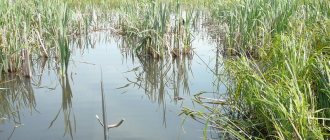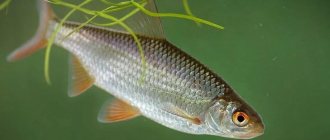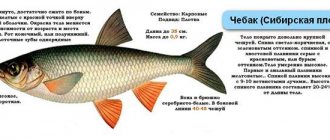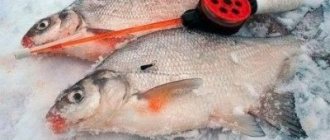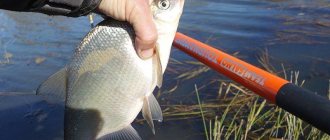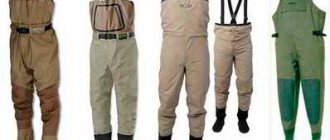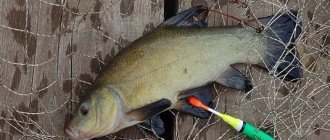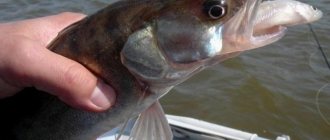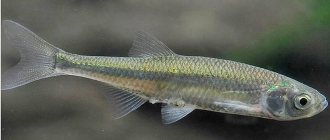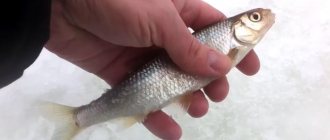Fishing is a way of life for which there is no season. And every season, every month has its own nuances that affect a successful catch. Neither the scorching sun nor the bitter frost stops trekking lovers. Therefore, roach fishing in November is of particular sporting interest. Roach fishing in November is very good.
Having fattened up for winter, specimens can be found weighing both 300 grams and half a kilogram. With the right approach, you can reap a good harvest in one go. At this time they fish from a boat and from the shore, on a feeder and on a float, and there are even more people who want to compete than in the summer.
Peculiarities of life of the inhabitants of fresh water bodies in autumn
All nature is preparing for winter and the inhabitants of fresh water bodies are no exception. Outwardly, this may be almost imperceptible - they will become more transparent, the flow will slow down, and at the end of November ice will already appear on ponds, lakes and small rivers. The food becomes smaller every day: there are no larvae, no mosquitoes, no bloodworms, or other insects circling over the water. The life cycle of algae is over, they fall to the bottom and, rotting, produce carbon dioxide. Accordingly, the inhabitants of reservoirs adapt and get used to new conditions. The roach avoids shallow water, because now any enemy can see it. The rotting vegetation causes oxygen starvation in the fish, and the little remaining food - microorganisms and crustaceans - have long ago found deeper places and buried themselves deep in the silt.
Expert opinion
Valery Andreevich Sizov
Professional fisherman with 35 years of experience.
Atmospheric pressure fundamentally influences the behavior of roach. This is especially true for sudden changes - in such cases, the track completely loses interest in food, because... has difficulty breathing and is busy stabilizing its buoyancy. Therefore, when starting your preparations, pay attention to the weather forecast.
The period of forced migration begins - the track is looking for areas more saturated with oxygen and food. Typically these are areas where there is current or deeper recesses. Even a small circulation of water helps to breathe and nourish. Water brings food to the roach, washing it from the bottom, and carries the smells of food, to which the whole school immediately rushes, because starting from the first frost, almost all types of fish gather in schools. This feature is typical for the cold season - together it is easier to fight for survival and withstand the onslaught of predators. And for a fisherman, this factor can bring a very good catch with the right approach, and it doesn’t matter where you are - on a river or lake. It is here that it is necessary to take into account a number of nuances that are typical for roach fishing in November.
Roach fishing in November
In Siberia, at least in its western part, and in the Urals, the common name for roach is chebak. Chebak has yellow eyes and is narrow, Soroga has red eyes and is wide. In the Arkhangelsk and Vologda regions, the commonly used name for the common roach is “sorog”. In Eastern Siberia, on the Yenisei, the commonly used name is “soroga”, “sorozhka”.
The roach is found throughout Europe east of Southern England and the Pyrenees and north of the Alps; in the rivers and lakes of Siberia, in the basins of the Caspian and Aral seas.
The semi-anadromous subspecies - roach and ram - are of greatest commercial importance in Russia; of the residential subspecies, only the Siberian roach is caught on an industrial scale. Ram and roach are eaten fresh, smoked and dried.
Roach has fallen out of demand in Northern Europe since the 1970s and has recently been recognized as a dangerous fish for the Baltic Sea. The fish feeds on zooplankton and grows for a very long time - as a result, in the absence of its industrial catch, water bodies begin to become overgrown and the water begins to bloom.
How to find fish
November. Sorozhka has already gathered in close flocks and left its native shores. Small cyprinids make it difficult to find their habitat by occupying small areas of water bodies. In addition, they become less active, slower, sleepier and lazy, trying to maintain strength. Not a trace remains of the former playful and active individuals. But the factor that plays into the hands of fishermen is that the roach does not have enough of its usual food and reacts more vividly to bait.
Most of the day and night, the track hides in deep holes. The school usually “comes to life” in the morning and goes in search of small crustaceans and various microorganisms in the bottom soil. Roaches stay away from other fish species and try not to enter into conflicts with them, so the appearance of other inhabitants, for example, breams, cannot serve as a reliable guide.
Best autumn habitats
The best places in late autumn are on small rivers, in tributaries and small channels - here it is much easier and faster to find a path than in large channels. When choosing depth, look for places from 2 to 4 meters. In such places, fish gather in large schools and are often found close to the shore. It’s easy to identify places where shoals may stand:
- steep bank - as a rule, there should be a good hole nearby;
- areas with reverse flow near the shore and edge;
- bushes, tree roots going into the water, stones and large snags.
It is also worth noticing a tree that has fallen into the water; it allows the roach to hide from the current.
Where to find holes and edges?
Holes and gullies are found in any plane of the river. Near the coast and in the distance. Size here, in principle, is not important, the main thing is that here, in the mud, there is food (crustaceans, bugs and other microorganisms buried in the mud) and there is no strong current, which means it is possible to find a large school. If the topography of the reservoir is familiar to you, it is worth fishing all these places that are comfortable for fish.
Where there are no holes, there will definitely be edges. The bottom relief of our rivers is literally replete with these irregularities.
Expert opinion
Valery Andreevich Sizov
Professional fisherman with 35 years of experience
. An edge is a cliff of the bottom, a sharp change in depth or an inclined “dump” - a small slide under water. The place to look for schools of roach is under the dumps closest to the shore.
What are the benefits of driftwood and stones?
Bushes, snags and large stones are sure to attract the attention of the fisherman. As a rule, they are located close to the shore. Tree debris, roots going into the water, large boulders allow roaches to hide from direct currents and predators and are able to retain silt in which food is “hidden”. These places are the most promising for November fishing.
It would seem that you have found a place and caught luck by the tail? But in reality, I found a large school, but there was no catch except a couple of fish. Successful fishing can be ruined not only by the wrong place. To make your trophies happy and arouse the envy of your friends, let’s see what they use to catch roach in November.
Search for fish
Where to look for roach in a pond? Finding a roach in November is not difficult, it tries to stick to its summer sites, the only thing that can change is the depths, they increase as the weather gets colder. The favorite places for roaches are quiet bays with depths of more than a meter, not heavily silted and overgrown. Fishing in shallow holes near steep banks is very promising; it will be a plus if there are trees on the shore leaning towards the water. Very often, roaches are found on the borders of reed thickets with clear water.
The only thing you should not forget about is that schools of roach move to deeper places with the arrival of cold weather.
The most important point: Tackle
How to ruin a good fishing trip? Choosing the wrong gear will help you with this. Moreover, the age-old question - for a float rod or for a feeder? If you are going to fish in an unfamiliar place, take all your fishing gear. While the track is “grazing” on the bottom soil, it is better to give preference to the feeder. Bottom gear is more effective at long distances.
But if the school is in a hole and right next to the shore? It is clear that the choice will be made in favor of the “float”. The good old way will spice up any fishing trip. But this type of “hunting” has its own difficulties in this cold, almost winter month. In clean and clear water, fish become cautious, so you need to be more careful when choosing gear:
- It is better to put summer fishing line aside and choose the most transparent, thinner but low-stretch line - no thicker than 0.12 mm and 0.14-0.16 mm for a Bolognese fishing rod;
- for a leash, a diameter from 0.08 to 0.1 mm is suitable;
- The length of the leash is about 10-15 cm.
- You can also scare the fence with a hook - you need the thinnest and sharpest specimens from 3 to 5 numbers (18 - 23 by European standards);
- choose a lead bead as a sinker.
Expert opinion
Valery Andreevich Sizov
Professional fisherman with 35 years of experience
Sorog meat is easily digestible protein, vitamins and minerals, including primarily polysaturated Omega 3 acids. Roach has a low calorie content per 100 g - 88 kcal.
Float
Pay special attention to the float. Bites this season become almost unnoticeable and sluggish, which is why so much attention is paid to the alarm. A small float designed for a load capacity of up to 0.5 g should have a thin antenna and be very light. The top should be painted in a contrasting color. On clear water with a light bottom - in a dark tone, and on dark water, vice versa.
Of course, the weight of the float should be small, this is what achieves the greatest sensitivity of the equipment. Experienced autumn fishing enthusiasts have identified the most suitable models:
- olive-shaped - a classic option for deep fishing, copes well with ripples in the water, compatible with all types of fishing rods;
- standard version of the waggler type - for long distances;
- barrel - designed for use with fly and plug gear, suitable for fishing in waves and in strong currents;
- inverted drop - a float for deep fishing, has maximum sensitivity;
- elongated spindle - usually chosen when roach activity is low; sliding floats of a classic shape - for Bolognese rods.
The final choice in favor of one option or another can only be made by the fisherman himself after sufficient practice.
Fishing rod
Roaches are caught mainly at short distances, up to 60 meters, so for fishing on a still body of water, a rod with a length of 3.6-3.9 with a weight of up to 90 grams is selected. When fishing on a river with a strong current, use a rod with a weight of up to 120 or even 150 grams, it all depends on the expected weight of the feeders that are used in the rigs.
A heavy river rod is inconvenient for fast fishing, as a result of which it is used only when there is an urgent need for it. For short distances, it is enough to take a picker with a dough of up to 60 grams, and use feeders of the appropriate weight.
Specific models of rods are presented in fishing stores; as for manufacturers, Drennan, Preston, Daiwa are known in the best way in the feeder world. Our Volzhanka-type fishing rods are inferior in quality to branded models, but they have advantages and are relatively low in cost.
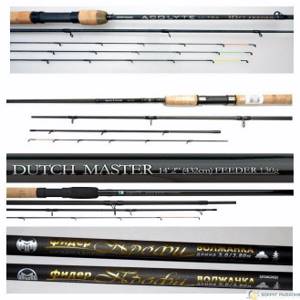
As practice shows, it is better to immediately purchase a high-quality feeder or picker so that it will last for several seasons. Changing equipment is a normal process for every fishing enthusiast, but savings should not be forgotten either.
It is more difficult for a novice feeder to immediately choose the most convenient form, so it is better to consult with experienced fishermen and make the right choice. Most fans of feeder fishing have several rods of varying lengths and power in their arsenal, which allows them to have convenient equipment in any situation.
Choosing a float rod
For fishing with a float in the fall, you can use different types of fishing rods:
- For coastal fishing, a fly rod with a blind rig is suitable;
- for extra precision in getting to the right place, choose a long plug;
- a match rod is used with a spinning reel and allows you to cast a fishing rod over long distances;
- Bolognese tackle is suitable for medium distance.
The simplest options, available even to beginners, are the fly rod and the Bolognese fishing rod.
Fly fishing rod
For a fly float, it is recommended to choose thin leashes with a length of at least 15 cm. The hooks, of course, are small and sharp. In order to hook a roach in time, hold the rod in your hands - at this time of year the fish tastes the bait for a long time and only then bites. For proper rigging, a line equal to the length of the fishing rod is installed on the rod. The fishing line is equipped with a float with cambrics and small weights, then a leash with a hook is attached. This is the fastest and easiest equipment option.
Bolonka
Bolognese tackle is used over long distances. The length of a telescopic rod with rings can be 6 meters. The combination of length and rigidity allows you to deliver the bait exactly to the right place. In this case, the coil is not needed; it can be replaced with a small drum. The line is pulled with one hand and cast with the other, which allows you to increase the distance. The recommended line diameter is 0.2 mm with a leash thickness of 0.16 mm.
Fishing tactics
When catching roach on a feeder, you should take into account that this is a passing fish and attracting it to a given point is more difficult than holding it with the help of properly selected bait.
At the beginning of the session, the angler selects promising places with a hard bottom and makes a starting feeding. The bait “gathers dust”, indicating a “beacon” for fish, and with each subsequent cast, new portions of food attract fish to the bottom layer.
To select a promising location, it is not necessary to cast the tackle over a super long distance, because even in the immediate vicinity of the shore, roach is available in the required quantity.
In the spring, when the water is just warming up, coastal areas should be explored first, although at other times of the year aquatic inhabitants look for insects and other food near reeds or trees hanging over the water.
Catching roach in late autumn on a picker or feeder is also an exciting activity and decent catches, which are even filmed, happen very often. When starting fishing, it is advisable to select several points at different distances and fish them in search of fish.
In spring and autumn there is no need for large volumes of bait, the main thing is that with the help of a feeder it is regularly supplied to the fishing spot and stimulates the interest of the fish, provoking it to bite.
You don’t need to think that roach is not as cunning as carp, bream, or even crucian carp; to catch it, you also need to make a lot of effort, use special baits, small hooks and attractive baits.
If the nearby points do not bring the desired result, move to long distances, look for fish and this will bring the desired results. A pause in the bite, when large roach are being caught, means that it is time to move to a new point, and not wait until the fish comes for another portion of food.
To ensure accuracy of casting at a given distance, after selecting a point, the fishing line is inserted into a clip and this prevents accidental mistakes. When fishing for carp or grass carp on a feeder, clipping is undesirable, because when biting, the trophy will pull the rod off the stand and you should respond to it in a timely manner.
Roach does not create such problems and when fishing for it, clipping helps to keep the same distance regardless of the strength of the wind, current or other factors, and the fish is simply not able to pull the rod.
Some fishermen use marker rubber to record the required distance. This decision has the right to life, but it is more like reinsurance in case a trophy fish is accidentally caught on the hook.
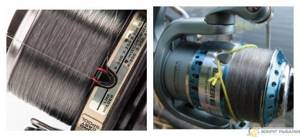
When purposefully fishing for roach on a feeder, no additional reinsurance is required and clipping is sufficient to fix the fishing distance.
Feeder
Not forgetting about thin and inconspicuous gear, in November they give preference to dark wattle with a cross-section of 0.1 with fluorocarbon leaders. The diameter should be as small as possible, usually from 0.08 to 0.1 mm. To protect the leash when pulling out prey, we use a fidegram measuring from 30 to 80 cm. The optimal length to start the process is 0.5-0.6 meters. When notches appear and there is no bite, the leash is shortened and vice versa.
Often in the process you want to increase the distance to more than 60 meters. For these purposes, use a “medium” rod 3.5-4 meters long. The spool capacity per reel is from 3000 to 4000 and the most sensitive tip for a more accurate bite signal.
Subtleties of fishing on a feeder
In the cold season, fishing can be done after 9 a.m. and throughout the day. To begin with, it is worth spending more time on reconnaissance and identifying promising points. Unlike the warm season, the low frequency of bites allows you to use two feeders at once. Having placed the fishing rods on the stand, it is better to observe them from the side. In this position, you can notice even the most delicate trap. We start fishing after the first feeding, while breaks after the initial bite can reach half an hour or more.
It is better to refill the feeder every ten minutes, while not forgetting about aromatic animal feed in every third feeder. When only one fishing rod is working, the second one can be removed or the distance can be changed, a different edge can be selected, or another food can be added. Regardless of the gear, the bite of November roach is intermittent. Do not despair - roaches feed in schools and for no more than one or two hours. After a short pause, other tracks will come. Unlike summer fishing, larger specimens are caught in the fall, especially in stable weather. With minimal wind, normal pressure and properly selected gear, only laziness or poor feeding will prevent you from bringing home a good catch.
Fishing process
Before fishing, up to ten balls of bait the size of a ground tennis ball are thrown into the water. Next, the bait is thrown in each time after three roaches are caught. After casting the tackle into the work area at your fishing spot, control the tackle rather than throwing it to the mercy of the current and wind.
To do this, constantly pull the tackle towards yourself. This will significantly increase the number of bites. Store the caught fish in a cage. She will be alive in it throughout the entire fishing period in November.
What does the trackfish bite on in late autumn?
Such a popular and simple summer bait as porridge will only harm you on a November day. Steamed pearl barley and loose millet are irreplaceable for the warm season, but in cold water the fish will quickly get enough of this food at the very beginning of fishing. It's all about metabolism - the closer to winter, the slower food is digested.
So what to catch?
roach? Use foods that do not have high nutritional value. As a rule, these are “dusty” feeding balls at the start and they should crumble near the ground or upon touching the day, and not on the surface of the water. Prepare 3-4 balls the size of a small apple to start with and one every half hour thereafter. Thus, you will tie the whole joint to one place, but leave it hungry.
The second option is to feed more often, but in even smaller portions; this method allows you to reduce visibility for a longer time and interest the track. You need to focus on the current situation, the density of the school, the intensity of the current, the weather and the activity of the fish. What should be included in the autumn bait and what does it bite on?
November roach?
- A finely dispersed mixture containing dusty floating particles, such as ground cake, ground hemp seed, barley chaff, milk powder with a small proportion of small bloodworms or other goodies.
- Spicy seasonings for flavor - various peppers, garlic, cloves, cinnamon and others.
- Flavors with meat and sea scents, such as crab.
- The fishing point should be at the very point where the bait particles settle, so the balls need to be thrown a little higher upstream than the float is located.
Feeding
Roaches are always fed, even in winter, but during the cold period, including November, special requirements are put forward for bait. It should be low in nutrition, only attract fish, and not saturate them. A simple mixture consisting of cake, breadcrumbs and ground rolled oats copes well with this task. And if you add some dried daphnia (aquarium food) to it, the roach’s appetite will increase significantly.
It is advisable to mix the bait in a pond, mixing it with soil taken from the shore. It will make the mixture heavier and also serve as a binding component, allowing you to quickly roll the bait balls (when fishing with a float rod). The bait is supplied to the fishing point in small portions so as not to overfeed the fish.
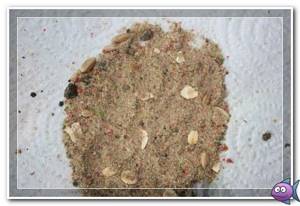
Bait
The capricious mood of the roach must be taken into account and it is necessary to have various animal baits with you. The instability of fish behavior in late autumn is most clearly expressed - until lunch the fish went well on maggots, and then died down. We changed the food to bloodworms or dung beetles and the bite picked up again. Do not forget about combined options (sandwiches), for example, bloodworms and maggots, as well as the combination of worm + bloodworms. Sorog takes a good bait with a jig, and among animal baits you should pay attention to a pig's ear or a cow's udder, cut into very small pieces.
Maggots
In late autumn, not only live maggots are used, but also black, pupated ones; roach also works well on scalded larvae. This bait floats up easily, so on muddy ground you can choose a short leash. It is not known why, but in November the roach prefers this particular version of maggot. Of the living specimens, it is worth paying attention to the small red larvae. Small and mobile, they somewhat resemble bloodworms.
Cow's udder and pig's ear
A painted udder or pig's ear can also successfully replace bloodworms. The udder or boiled pig's ear, peeled from the skin, is cut into tiny pieces no more than 3 mm. The raw materials are filled with red dye overnight and placed in the refrigerator. A day later the bait is ready. It must be said that despite the laboriousness of the process, this method is often more effective in winter than bloodworms.
Plant attachments
Cereals such as steamed wheat and lupine are sold in the markets in the animal feed departments. Before cooking, they are soaked for 12 hours and boiled for three to four hours until fully cooked.
Bait and bait
It is simply impossible to catch a roach without bait. No, of course, you can catch one or two, but that’s the limit. Boiled millet porridge and plus 400 grams of sunflower cake are used as bait. It is enough to cook millet from one kilogram of millet cereal. After cooking, the mixture is stirred and semolina is added to the balls for gluing.
Maggot, bloodworms and pearl barley porridge are used as bait. You should always take all these baits with you, since it is not clear what will be used to catch roach today.
